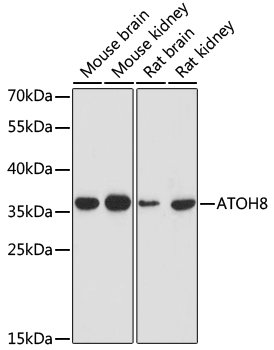-
Product Name
ATOH8 Polyclonal Antibody
- Documents
-
Description
Polyclonal antibody to ATOH8
-
Tested applications
WB
-
Species reactivity
Mouse, Rat
-
Alternative names
ATOH8 antibody; HATH6 antibody; bHLHa21 antibody; protein atonal homolog 8 antibody
-
Isotype
Rabbit IgG
-
Preparation
Antigen: A synthetic peptide of human ATOH8.
-
Clonality
Polyclonal
-
Formulation
PBS with 0.02% sodium azide, 50% glycerol, pH7.3.
-
Storage instructions
Store at -20℃. Avoid freeze / thaw cycles.
-
Applications
WB 1:500 - 1:2000
-
Validations

Western blot - ATOH8 Polyclonal Antibody
Western blot analysis of extracts of various cell lines,using ATOH8 antibody at 1:1000 dilution.Secondary antibody: HRP Goat Anti-Rabbit IgG (H+L) at 1:10000 dilution.Lysates/proteins: 25ug per lane.Blocking buffer: 3% nonfat dry milk in TBST.Detection: ECL Basic Kit .Exposure time: 90s.
-
Background
Transcription factor that binds a palindromic (canonical) core consensus DNA sequence 5'-CANNTG- 3' known as an E-box element, possibly as a heterodimer with other bHLH proteins. Regulates endothelial cell proliferation, migration and tube-like structures formation. Modulates endothelial cell differentiation through NOS3. May be implicated in specification and differentiation of neuronal cell lineages in the brain (By similarity). May participate in kidney development and may be involved in podocyte differentiation (By similarity). During early embryonic development is involved in tissue-specific differentiation processes that are dependent on class II bHLH factors and namely modulates the differentiation program initiated by the pro-endocrine factor NEUROG3 (By similarity). During myogenesis, may play a role during the transition of myoblasts from the proliferative phase to the differentiation phase (By similarity). Positively regulates HAMP transcription in two ways, firstly by acting directly on the HAMP promoter via E-boxes binding and indirectly through increased phosphorylation of SMAD protein complex. Repress NEUROG3-dependent gene activation in a gene-specific manner through at least two mechanisms; requires only either the sequestering of a general partner such as TCF3 through heterodimerization, either also requires binding of the bHLH domain to DNA via a basic motif (By similarity).
Related Products / Services
Please note: All products are "FOR RESEARCH USE ONLY AND ARE NOT INTENDED FOR DIAGNOSTIC OR THERAPEUTIC USE"
